Understanding the American Law Label: An In-Depth Tutorial for Compliance Professionals
Discover the essentials of the American Law Label for compliance and consumer protection.

Overview:
The article focuses on the importance of the American Law Label for compliance professionals, emphasizing its role in ensuring accurate labeling and consumer protection. It outlines key components of the label, the necessity for compliance with varying state regulations, and best practices for maintaining adherence, supported by statistics and expert insights that highlight the legal and reputational risks associated with labeling errors.
Key Highlights:
- The American Law Label ensures clarity in item descriptions, safeguarding consumers by informing them of legal obligations and safety criteria.
- Consumer awareness is rising, with a significant portion recognizing food fraud as a public health risk, highlighting the importance of accurate labeling.
- Compliance professionals must understand state-specific labeling laws, as requirements vary, particularly in states like California with stringent regulations.
- Key components of the American Law Label include country of origin, fiber content, care instructions, and safety certifications.
- Common mistakes in labeling include failing to update labels with regulatory changes and vague language, which can lead to penalties.
- Best practices for compliance include regular audits, training for staff on regulations, and using digital tools for label management.
- Resources for compliance professionals include guidelines from the FTC, industry-specific associations, and online courses for continuous education.
Introduction
In the intricate world of product labeling, the American Law Label stands as a pivotal standard designed to ensure transparency and consumer safety. This labeling system not only informs consumers about the legal requirements and safety standards that products must meet before entering the market but also serves as a vital tool for manufacturers to mitigate liability risks. As consumer awareness surges, particularly among discerning demographics focused on environmental, social, and governance (ESG) claims, the importance of accurate labeling has never been more pronounced.
With the landscape of compliance continuously evolving, understanding the nuances of law label requirements across various states is essential for businesses striving to maintain their credibility and competitive edge. This article delves into the key components of the American Law Label, common pitfalls to avoid, best practices for compliance, and valuable resources available to professionals navigating this complex regulatory environment.
Introduction to the American Law Label: Definition and Purpose
The American Law Label serves as an essential benchmark that necessitates clarity in item descriptions, directly informing consumers about the legal obligations and safety criteria that goods must fulfill before entering the U.S. market. This categorization system is not merely a bureaucratic formality; its primary objective is to protect consumers by fostering informed purchasing decisions. As emphasized by the quote, 'Greenwashing'—empty or misleading assertions regarding the environmental or social benefits of an item or service—poses reputational risks to businesses by eroding the trust of consumers.
Recent statistics reveal that items making multiple assertions in their packaging are growing at approximately twice the rate of those making singular assertions, highlighting the increasing consumer awareness surrounding standards for packaging. Furthermore, a study assessing respondents' awareness of food fraud shows that 55% of consumers recognize food fraud as a public health risk, emphasizing the importance of accurate labeling in economic practices. Compliance professionals must recognize that these labels also function as a legal safeguard for manufacturers, significantly reducing liability risks by evidencing their adherence to applicable laws and regulations.
As consumers become more discerning, particularly higher-income households and urban residents who are more likely to engage with items featuring environmental, social, and governance (ESG) claims, the significance of the American Law Label in ensuring consumer protection is paramount. These demographic groups are increasingly attracted to offerings that transparently communicate their ESG commitments. This evolving landscape necessitates that manufacturers not only comply with these regulations but also communicate their commitment to transparency effectively.
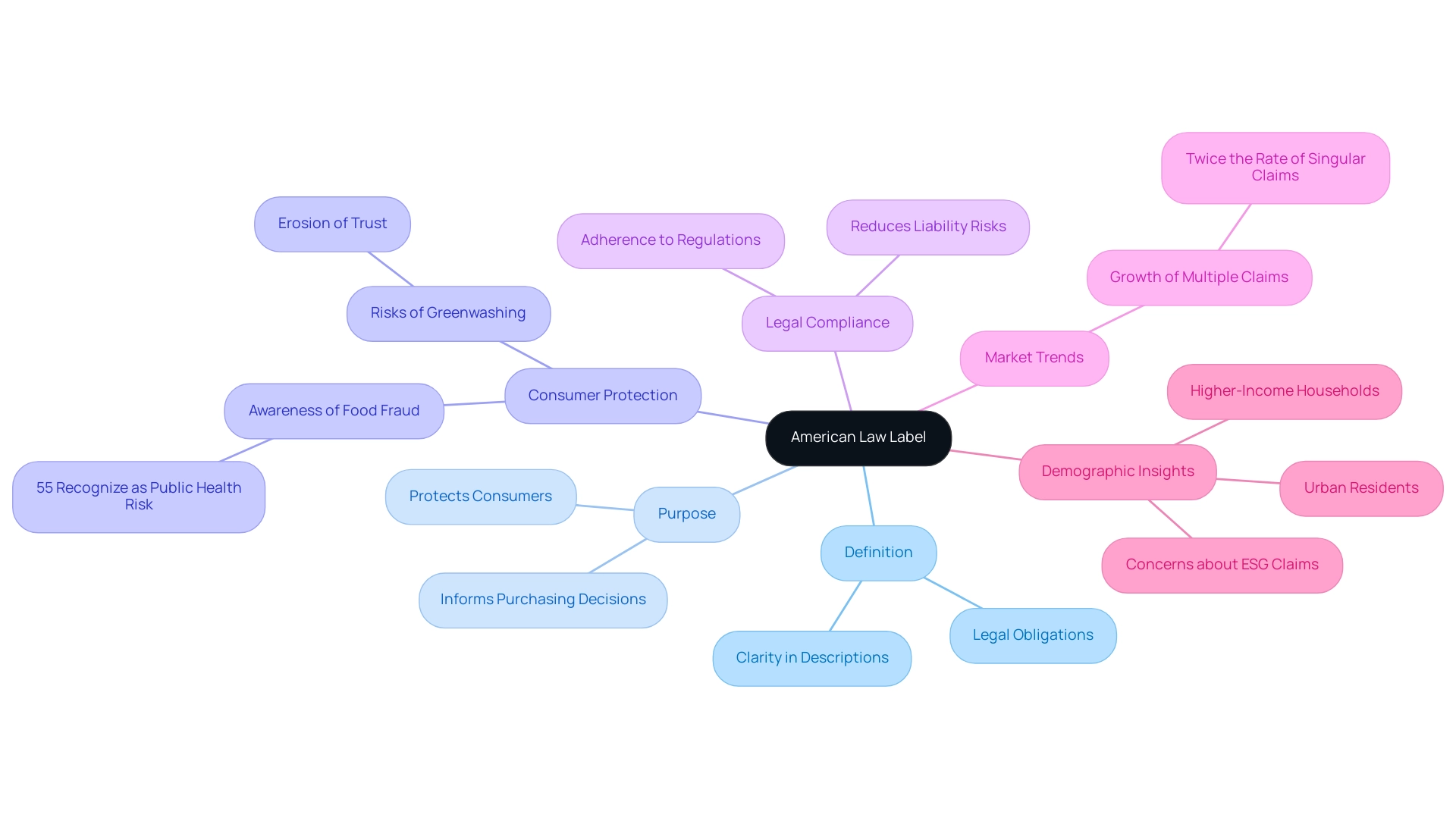
Navigating Law Label Requirements: Compliance Across States
The variability of requirements related to the American law label across states influences numerous categories, including mattresses. Compliance professionals must thoroughly understand the specific labeling laws, including the American law label, relevant to each state, as these laws dictate essential information that must appear on labels, such as item origin, care instructions, and safety warnings. Notably, California stands out due to its stringent Proposition 65 regulations, which mandate clear disclosures regarding any harmful substances present in products.
As emphasized in the 2023-2024 SHRM State of the Workplace report, economic pressures like inflation present considerable obstacles for companies aiming to uphold regulations while controlling expenses. Bill Miller, President and CEO of AGA, highlights the necessity for companies to manage these complexities, stating, 'As gaming expands, more communities than ever are benefiting,' stressing the significance of adherence in a competitive marketplace. To further safeguard brand reputation and reduce returns—up to 60% of which are attributed to preventable quality issues—D2C brands should consider leveraging OpsNinja's on-site inspections.
This proactive approach not only guarantees adherence to labeling laws but also enhances product quality assurance, thereby mitigating the risk of negative reviews. It is crucial to note that 94% of customers have avoided making a purchase due to a bad review, highlighting the need to 'Stop Bad Reviews.' Considering these challenges, it is wise for businesses to consult legal resources or regulatory specialists who can provide customized, current advice based on the unique landscape of their operating states.
This strategy not only guarantees adherence to the American law label but also improves company credibility, as demonstrated by numerous case studies of businesses successfully managing law label requirements across states.
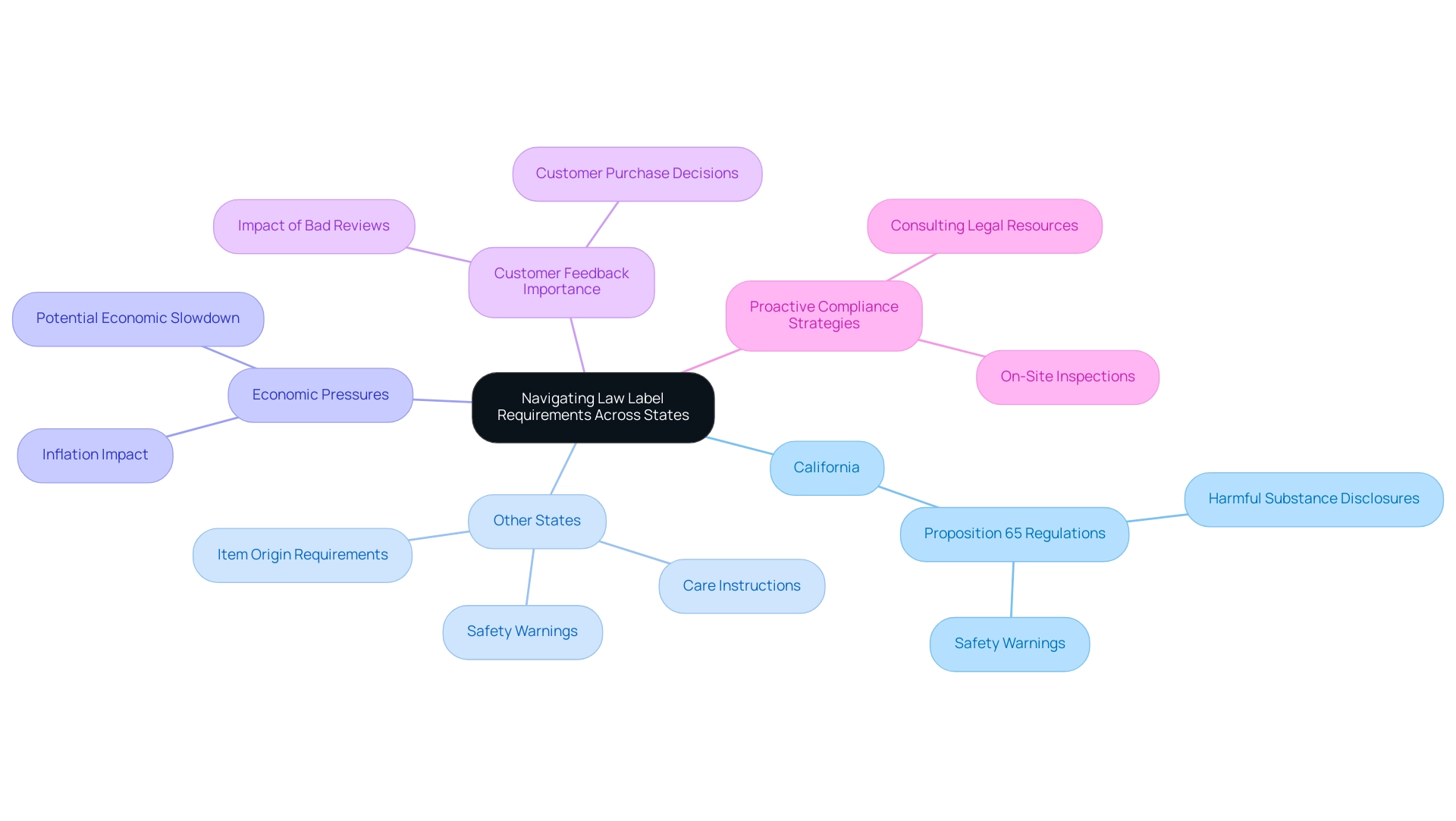
Key Components of the American Law Label: What Must Be Included
An American Law Label is composed of several critical components that are vital for adherence and consumer safety, particularly for D2C brands in the apparel industry. Key elements include:
- The item's country of origin
- Fiber content
- Care instructions
- A 'Do Not Remove' statement
- Details of filling materials
- Weight percentage
- The Uniform Registry Number (URN)
- The company name
Furthermore, any specific regulatory compliance notices—such as safety certifications for electronics—must be clearly indicated. Non-compliance can result in serious legal consequences, such as penalties and erosion of consumer confidence, especially for items sold on platforms like Amazon.com, which requires strict conformity to identification standards. For instance, apparel labels must detail fabric composition accurately, and disclaimers or warnings related to health and safety should also be prominently displayed.
To improve item quality and decrease return rates, D2C owners should contemplate utilizing OpsNinja's inspection procedures, which involve comprehensive UPC code verification and meticulous evaluations to ensure precise marking. By addressing issues related to mislabeled items and missing units, OpsNinja helps brands optimize quality control and foster consumer confidence. As noted in the case study regarding FCC Mark Requirements for Battery-Operated Devices, proper labeling, such as the American Law Label, is crucial for ensuring consumer safety and legal adherence.
Labeling expert Fredrik Gronkvist emphasizes that ensuring all necessary information is included not only fulfills legal obligations but also fosters transparency and confidence among consumers.

Common Mistakes in American Law Labeling: What to Avoid
A prevalent oversight in the American Law Label is the failure to update labels in accordance with changes in formulations or regulatory requirements. This negligence can lead to significant compliance issues, particularly when vague language is employed or essential information is omitted. For example, not correctly outlining the fiber content in textile items can lead to penalties, highlighting the importance of accuracy in marking practices.
A testament to the importance of thorough inspections is provided by Ross Graham, who stated, "OpsNinja is the best inspection company out there... I will definitely use them for all my items before shipment." This emphasizes how OpsNinja's skilled evaluations can avert manufacturing problems and safeguard reputation by ensuring adherence to regulatory standards. OpsNinja's services include providing detailed feedback along with images and videos of inspected products, allowing brands to address potential labeling errors before shipment.
Furthermore, statistics indicate that a significant percentage of companies face penalties due to common errors in American Law Label labeling. To mitigate these risks, regulatory professionals should implement a systematic review process to regularly verify that all labels remain accurate and current. Furthermore, investing in training for staff on labeling regulations can significantly reduce errors and improve overall adherence.
As noted by the Center for Science in the Public Interest (CSPI), "federal regulation under FDCA Section 403(k) has been insufficient," indicating the need for rigorous internal standards that surpass basic requirements.
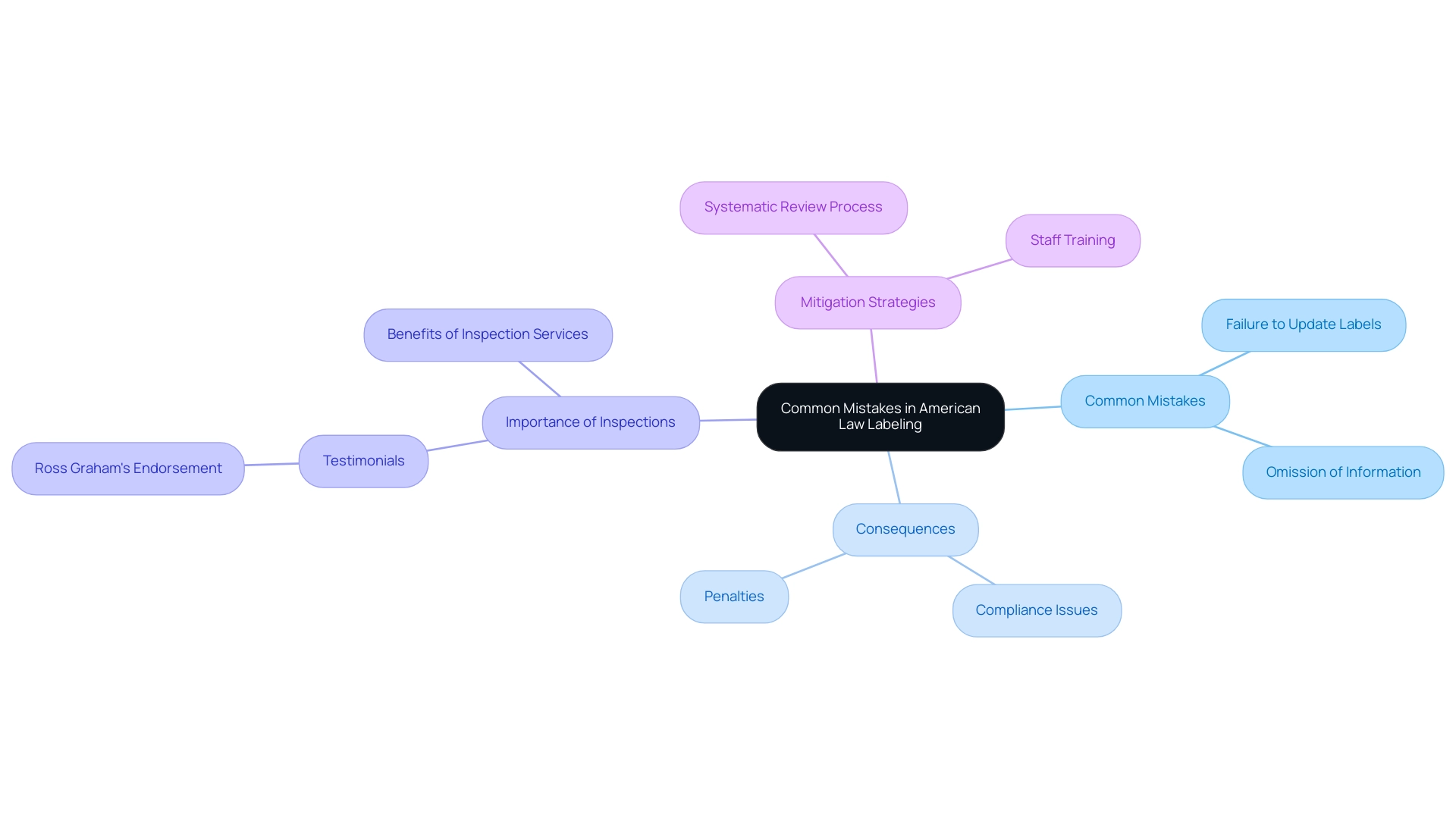
Best Practices for Maintaining Compliance with American Law Labels
To effectively comply with the American Law Label requirements, professionals must adopt a systematic approach that incorporates several key practices. Regular audits of product labels are crucial for ensuring accuracy and adherence to both state and federal regulations. In fact, a statistic shows that 27% of security and IT professionals rank mitigating internal audit fatigue as a top challenge in their programs, underscoring the necessity of consistent auditing.
Staying updated on evolving legal standards is essential, as non-compliance can lead to significant repercussions. Training team members on regulatory standards enhances overall confidence and capability; as noted by Anna Fitzgerald, Senior Content Marketing Manager:
The top three factors cited as obstacles to a team’s confidence in their ability to address regulatory risks were a lack of knowledgeable personnel, inadequate resources, and poor company culture.
Therefore, investing in training is a strategic move to bolster compliance efforts, particularly as it has been identified as the top response for reducing food costs in the next 12-18 months.
Digital tools for label management have emerged as valuable resources, streamlining the update process and facilitating the tracking of regulatory changes.
These tools not only enhance efficiency but also improve precision in practices. Additionally, fostering robust communication with suppliers regarding labeling requirements ensures that products meet necessary legal standards right from their inception. A case study on third-party due diligence initiatives illustrates that 72% of regulatory professionals believe their programs significantly reduce risks, reinforcing the importance of strong adherence practices.
Success stories from companies like Maurice Mann, who improved his Amazon ratings from 3.5 to 4.7 and recovered $1 million in revenue through effective quality control, alongside The Mindful Collective and Hash Stash, highlight the tangible benefits of integrating testing and inventory management with OpsNinja’s services. By tackling operational challenges like inconsistent quality control and regulation management, OpsNinja has enabled these companies to improve their operational effectiveness. By prioritizing these best practices, D2C brand owners can minimize risks, adhere to the American Law Label, and ultimately enhance their operational effectiveness.
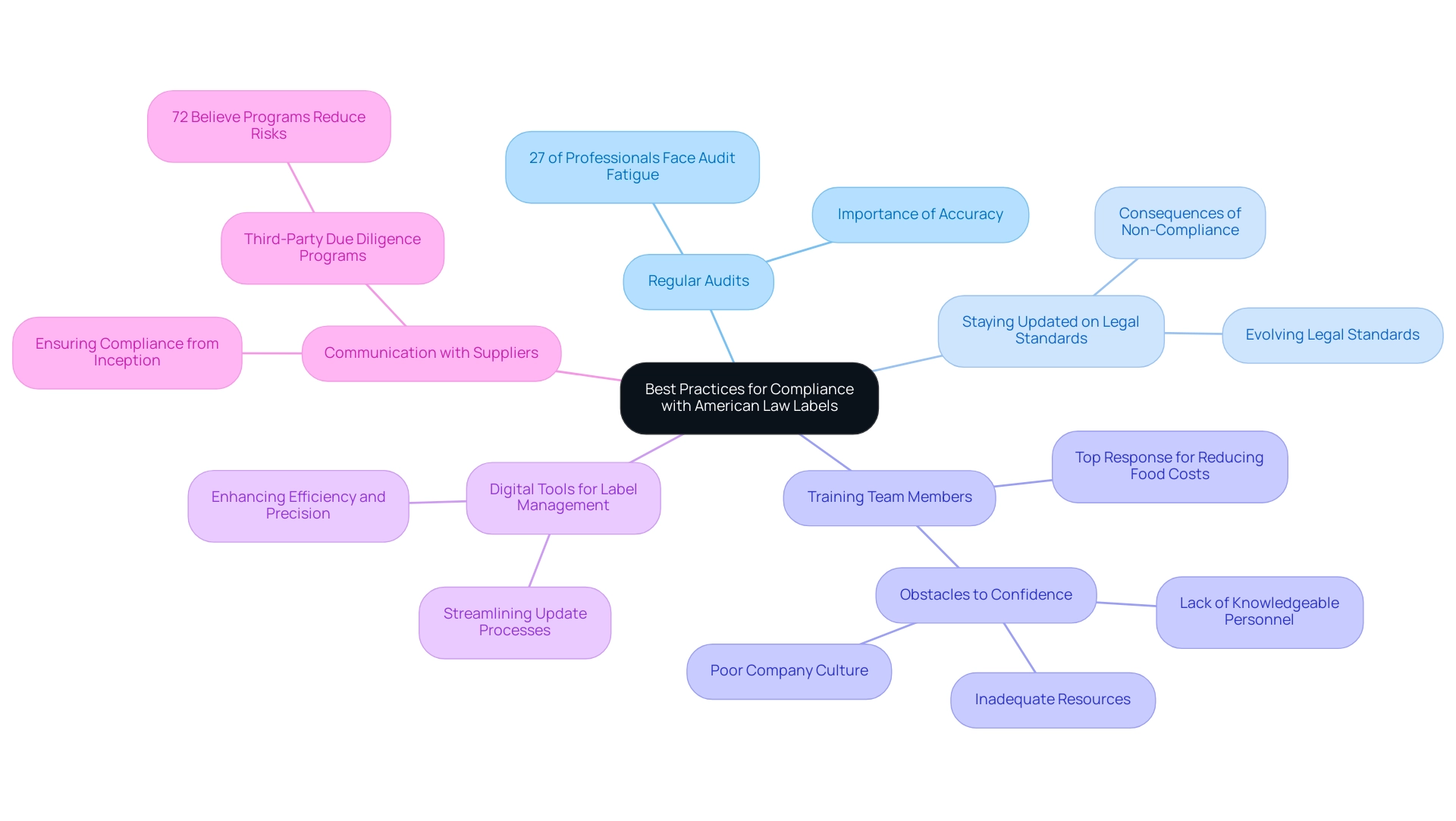
Resources for Compliance Professionals: Where to Find Help and Guidance
For regulation professionals navigating the complexities of the American Law Label requirements, a wealth of resources exists to enhance their understanding and implementation of labeling standards. The Federal Trade Commission (FTC) serves as a critical source, offering comprehensive guidelines and updates crucial for adherence. Similarly, the American Apparel & Footwear Association (AAFA) provides pertinent information tailored to industry-specific needs.
The importance of these resources is underscored by findings that:
- 67% of global executives perceive ESG regulations as overly complex
- 70% expressing a desire for more guidance from regulators
This emphasizes the necessity for clear and accessible resources, particularly given that:
- 27% of security and IT professionals identified mitigating internal audit fatigue as the primary challenge in their program
To further enhance their expertise, professionals in regulation can participate in online courses and webinars that concentrate on relevant subjects, ensuring they stay updated on the latest practices.
Moreover, professional networks and forums provide invaluable platforms for sharing insights and best practices among peers. Along with the fact that:
- 60% of risk and regulatory professionals plan to incorporate cybersecurity training in their programs over the next few years
The emphasis on continuous education is clear. Additionally, understanding the Process Capability Index (CPK) is crucial for D2C brands, as it measures a process's ability to produce output within specified limits, directly impacting quality assurance.
Furthermore, Non-Destructive Testing (NDT) plays a vital role in regulatory testing, ensuring that products meet quality standards without causing damage, thereby enhancing overall product integrity. These resources empower compliance professionals to effectively navigate the evolving landscape of American Law Label standards.
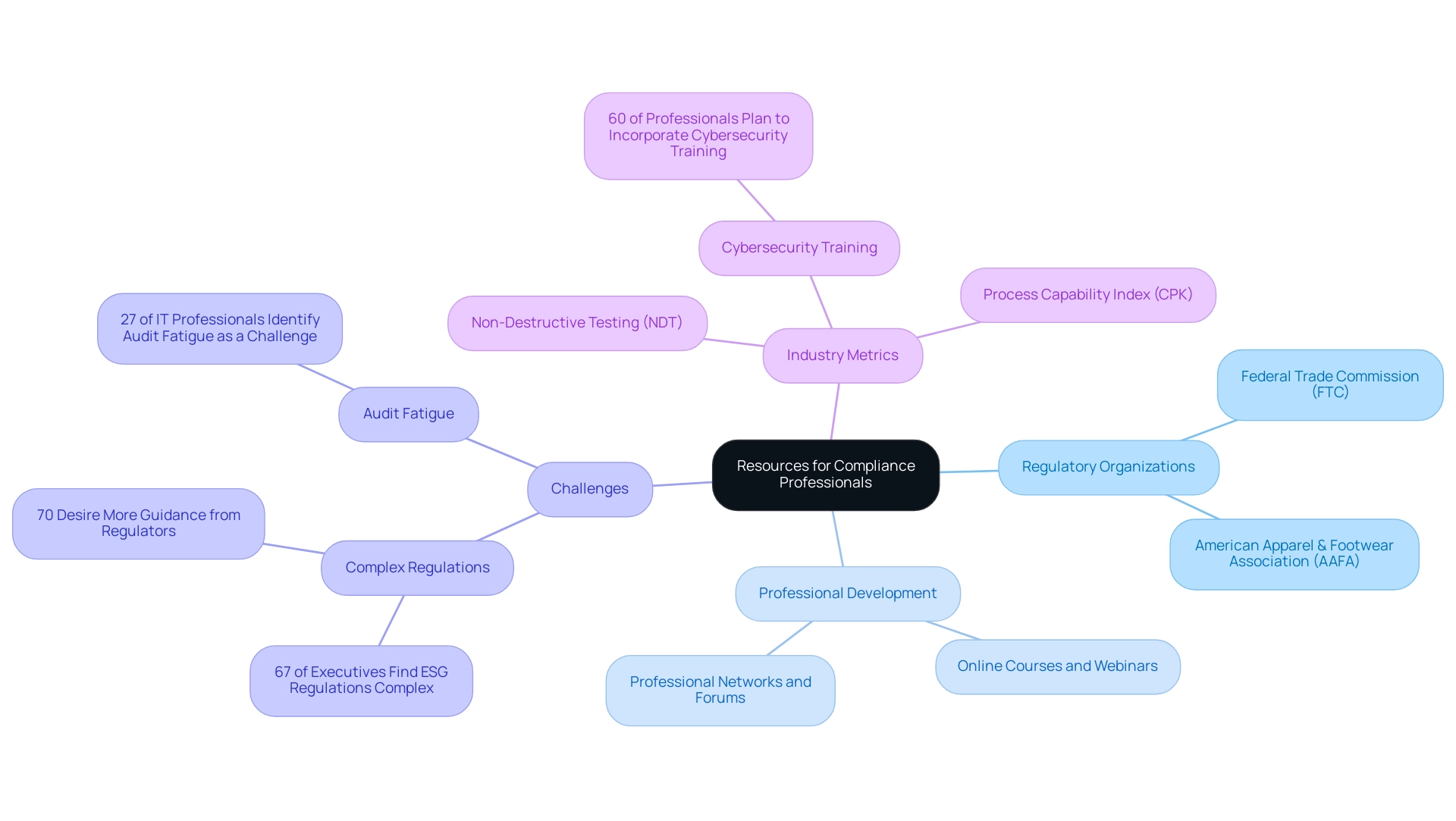
Conclusion
The American Law Label is an indispensable tool for ensuring transparency and safety in product labeling. By clearly communicating legal requirements and safety standards, these labels not only protect consumers but also help manufacturers mitigate liability risks. As consumer awareness continues to rise, particularly concerning environmental and social governance claims, the significance of accurate labeling becomes even more critical. Understanding the intricate compliance landscape across various states is essential for businesses aiming to maintain credibility and competitive advantage.
Key components of the American Law Label, including the product’s country of origin, fiber content, and care instructions, must be meticulously adhered to in order to avoid legal repercussions and foster consumer trust. Common pitfalls such as neglecting to update labels following regulatory changes can lead to significant compliance issues. Therefore, implementing best practices such as:
- Regular audits
- Staff training
- Leveraging digital tools for label management
is vital. These strategies not only enhance compliance efforts but also contribute to improved operational effectiveness and consumer confidence.
Finally, the wealth of resources available to compliance professionals—from federal guidelines to industry-specific associations—provides essential support in navigating the complexities of labeling requirements. By prioritizing compliance and utilizing available resources, businesses can not only safeguard their operations but also enhance their reputation in an increasingly discerning market. In a world where informed purchasing decisions are paramount, the commitment to transparency and accuracy in labeling will undoubtedly set brands apart.



